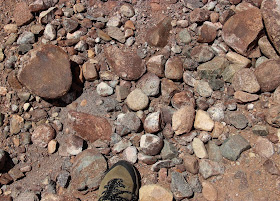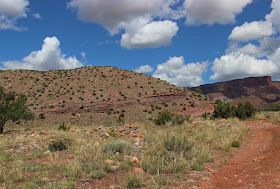"what rolled pebbles are to the Geologist—Battered relics of past ages often containing within them indelible records capable of intelligible interpretation" (John Herschel to Charles Lyell, 18361)
Three years ago, I walked up a desert wash in Utah that was littered with beautiful multicolored stones – hard igneous and metamorphic rocks worn smooth. They seemed out-of-place in a land of soft red sandstone, and in a sense they were. For their birthplace had disappeared long ago – a mountain range now gone. Their enchanting ghost-like presence was irresistible.
Those stones have been in the back of my mind ever since. I’ve wanted to visit their vanished source, the ghostly range. Last May I finally did. It was gone of course, but I stood on the remains of its slopes, and marveled at how we can conjure up the distant past from battered stones.
 |
Standing on an ancient alluvial fan.
|
The hard smooth stones I found in the wash and the surrounding soft red rocks all belong to the Cutler Formation. Pinnacles, balanced rocks, sculpted ridges, and the like are often called “rock formations,” but geologists use the term more formally.
“A formation is a rock unit that is distinctive enough in appearance that a geologic mapper can tell it apart from the surrounding rock layers. It must also be thick enough and extensive enough to plot on a map.” (Utah Geological Survey)
 |
| Geologist |
These rocks are Herschel’s “battered relics” with “indelible records capable of intelligible interpretation.” But to interpret them intelligently, geologists must determine the grain size of their sediments:
 |
Classification of grains by size (source of values).
|
Measuring and classifying grains is tedious but informative. Grain size speaks to the environment of deposition and the proximity of the source. Even the laziest stream can carry fine sediments, often far from their origins. Larger grains need more energetic transport – faster streams on steeper gradients. The largest – boulders – are carried only by raging torrents, and dropped close to the source.
In the southeastern corner of Utah, Cutler rocks include a lot of mudstone – fine sediment carried all the way to what was then the coast of North America. Wind-blown sand formed dunes, now sandstone. Sometimes the sea advanced, adding limey mud which became thin beds of limestone.
 |
Cutler slopes below cliffs of Cedar Mesa sandstone, viewed from the Moki Dugway.
|
 |
Cutler outcrops capped with Cedar Mesa sandstone in the Valley of the Gods.
|
About a hundred miles to the northeast, in Fisher Valley near Moab, the Cutler Formation is noticeably coarser – mostly sandstone with beds of gravel and cobbles. Cross-bedding is common, both eolian (wind) and fluvial (streams). It’s thought that braided networks of streams crossed this area, sometimes passing through isolated dune fields. Braided drainages mean the gradient had dropped significantly and streams lost energy. This happens today below mountain slopes – below their alluvial fans (Fillmore 2011; see diagram above).
 |
Fisher Valley is where I found beautiful stones in a wash three years ago.
|
 |
One of the Fisher Towers, with fluvial (stream-deposited) sandstone and layers of gravel (click on image to view).
|
Last May I went to Gateway, Colorado – 15 miles northeast of Fisher Valley – to see “the only exposures of the very coarse, most proximal [closest to source] Cutler Formation” (Fillmore 2011, italics added). It took only a bit of searching to find some, below the Palisade. Here was the Cutler very near its ghostly source!
 |
Lower red slopes are the Cutler Formation; northwest of Gateway, east of Dolores River.
|
 |
| Next photos are from the outcrop on the bottom half of this slope. |
 |
| This is only 15 miles from Fisher Valley, but the sediments are much coarser. |
 |
Cobbles and boulders carried by energetic streams; the source wasn’t far away.
|
 |
A Cutler road is a rocky road!
|
Conglomerates alternated with sandstones and mudstones. These deposits have been attributed to swollen mountain streams that overflowed their channels, dropping rocks and mud on alluvial fans (Fillmore 2011).
The stones were as beautiful as the ones I found in the wash in Fisher Valley three years ago – polished multicolored igneous and metamorphic rocks.
 |
Conglomerates are sedimentary rocks even if the clasts (fragments) are igneous and metamorphic.
|
I found another photogenic Cutler outcrop, with everything from boulders to mudstone. Cross-bedding was obvious. Looking at these "battered relics" it was easy to imagine engorged streams rushing down mountain slopes, dropping debris as they slowed.
 |
Are the thin white layers caliche?
|
 |
During the early Permian, southeastern Utah and western Colorado were dominated by Uncompahgria (illustration based on interpretations from Fillmore 2011).
|
The fine-to-coarse progression of Cutler sediments, from southeastern Utah to western Colorado, points clearly to the source. It was mighty Uncompahgria – one of the ranges of the Ancestral Rocky Mountains. We often think of mountains as massive, abiding and immutable, but they too have lifetimes. Uplift of Uncompahgria began about 300 million years ago, and for a time it stood high. But after a hundred million years, erosion had reduced it to a low rolling landscape. Fifty million years later, it was gone.
“if we look carefully at rocks, if we use them to peer into the past and conjure up the world they came from, we find that mountains too are ephemeral.” (from We too are ephemeral ... just like mountains)
 |
After a 250-million-year layover on the slopes of Uncompahgria, these stones are again on the move, headed down a wash.
|
Footnote:
1 The quote at the top of the post comes from a letter from astronomer John Herschel to geologist Charles Lyell, an important early proponent of Uniformitarianism (Cannon 1961). See Suvrat Kher's recent post at Rapid Uplift.
Sources (in addition to links in post)
Cannon, EF. 1961. The impact of uniformitarianism: two letters from John Herschel to Charles Lyell, 1836-1837. Proc Am Phil Soc 105:301-314.
Ege, C. 2004. GEOSIGHTS: Fisher Towers – the towering red rock sculptures of Grand County, Utah. Utah Geological Survey.
Ege, C. 2004. GEOSIGHTS: Fisher Towers – the towering red rock sculptures of Grand County, Utah. Utah Geological Survey.
Fillmore, Robert. 2011. Geological evolution of the Colorado Plateau of eastern Utah and western Colorado. Salt Lake City: University of Utah Press.









Stunning. Besides the lesson in geology, which I truly appreciate, the rocks and the scenes are breathtaking. This is truly where art and science meet. :)
ReplyDeleteThanks, PP, for all your kind and encouraging comments.
Deletebeautiful post Hollis- you have made Herschel's words come alive!
ReplyDeleteThanks, Suvrat - I'm flattered!
DeleteReally enjoyed reading and learning Hollis, thank you, Frances
ReplyDeleteThanks, Frances, your comment is much appreciated. Glad you enjoyed the post.
DeleteThank you for a lovely post - I think I understand a bit more about it all now, although your desert landscape is so different from ours here in South Wales, which is still being acted upon by water.
ReplyDeleteI am reminded of Horse with No Name:
"I was looking at a river bed
And the story it told of a river that flowed
Made me sad to think it was dead"
I'm enjoying the geology lessons - and your great quotes from the past.
All the best :)
Thanks, squirrelbasket, for your encouraging comments. This post took a long time, it was hard to put the parts together in a clear way.
Delete"and the story it told" -- perfect! I think of that so much - how landscapes, rocks etc. tell stories. I'm glad you enjoyed the quotes. I love "connecting" with great geologists and botanists of the past.
Hmm. When it comes to geology I am always so jealous of Americans. You have so much great geology visible above ground. Here (with the exception of mines) you just get to look at yet another a forest and use your imagination.
ReplyDeleteI chuckled at your comment ... because it brought back fond memories of a geology teacher who liked to tease me (a botanist): "plants don't make the landscape, plants OBSCURE the landscape"
Delete